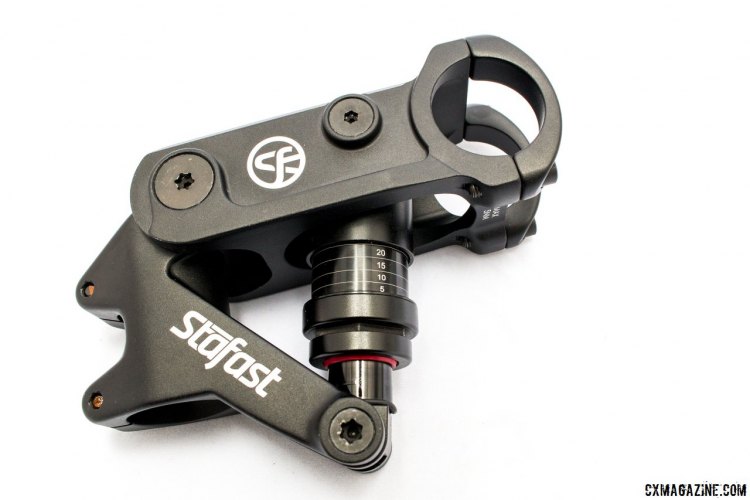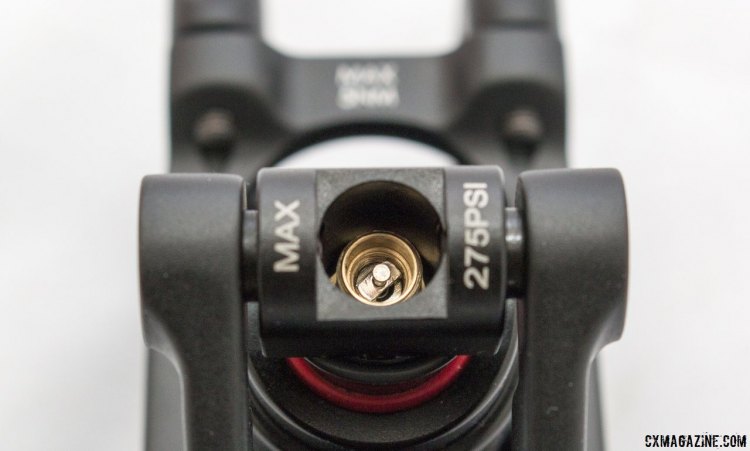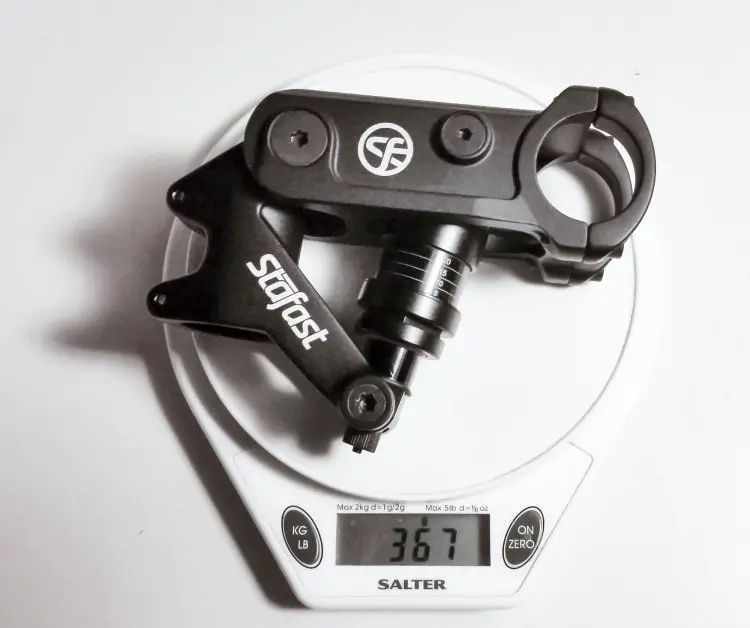Editor's Rating
For the cyclist who likes to ride their cyclocross bike everywhere, on all terrain, the Stafast stem does a good job of smoothing out a rough ride when a fine tubular is over-matched. We especially liked the Stafast stem on rocky gravel courses, but out-of-the saddle efforts take some getting used to.
Two months ago we took a first look at Stafast’s new take on the suspension stem. Now we have some initial feedback on the stem and our first in-depth review.
When we first previewed the stem, we noted that the cycling industry has a “cycle” of innovation that reinvents and re-engineers products that were popular years ago. Lace-up cycling shoes, wool jerseys, handmade cotton tires, cotton crochet gloves, small-diameter seatposts, and ovalized chainrings are all examples of this cycle, and are examples that typically appeal to the tradition-reminiscing cyclist, especially old-timer roadies who have discovered cyclocross.
Stafast, a Michigan-based company started by engineers Sam Kovalak and Charlie Brickey, is just one of several companies that believes the suspension stem is the next innovation that is ripe for refinement and reintroduction. It’s a reinvention that cyclocross racing purists may scoff at, and aging mountain bikers may chuckle at. But is there a place for adding some shock absorption at the handlebar? Open-minded cyclists can read on.

Suspension stems are back, with air dampened shocks and angle adjustment. Stafast air shock suspension stem. © Cyclocross Magazine
A Brief History of Suspension Stems and Drop Bar Suspended Bikes
We’ve noted the suspension stems from the ’90s from Softride, Girvin and others that have come and gone and dominated the Mountain Bike World Championships starting in 1992 in Bromont Canada, through 1994 in Vail, Colorado. Stems were dampened with elastomers, coil springs and oil shocks, and Softride’s system even featured a parallelogram design that didn’t force the bar to rotate under compression.
The latest drop bar suspension trend has been to offer saddle and rear-wheel suspension, and compliant posts from Specialized, Ergon and Cirrus are examples of this trend. Calfee’s Manta CX (reviewed in the upcoming Issue 30) and Trek’s Boone attempt to address rear wheel bumps. On one hand, this makes sense, since most of your weight is on the saddle and rear wheel. But as two decades of cross country mountain bike development have proven, it’s more important to suspend the front of the bike to navigate bumpy terrain safely and quickly.
Jacquie Phelan and John Tomac are two famous mountain bike pros who took to drop bar mountain bikes during their careers. While both had the option for suspension forks (Phelan at the end of her racing career), both also had the luxury of fat mountain bike tires to absorb much of the shock and vibration of off-road racing.

Suspension stems have transformed, and the Stafast air shock suspension stem is ready to leap into action on one of our test bikes. © Cyclocross Magazine
While larger wheels and tires and better suspension forks and full suspension frames now dominate the mountain bike scene, cyclocross and gravel races are still typically tackled on fully rigid machines. Yet during gravel races, especially rougher ones up in the mountains like the Lost and Found, racers can take quite a beating, and unexpected rocks and bumps can throw even great bike handlers off their bikes.
Does the popularity of gravel racing and “adventure” riding mean there’s a new market for the simple, lightweight suspension found on suspension stems? An alternative to buying a bike like Cannondale’s new Slate?
Stafast: Adjustable Suspension and Positioning
The Stafast takes a different approach to the suspension stems than the decades-old designs we’ve seen in the past. The biggest change is that the stem doesn’t rely on an elastomer or metal spring, but instead uses an air shock/dampener that is highly adjustable by the included shock pump. Recommended pressure ranges from 0 to 275 psi, which allows racers to highly tune the dampening and rebound of the stem.
The shock has about 1 cm of travel, maximum, but don’t make the mistake thinking that’s a minuscule amount you won’t feel. The shock is attached to the stem about 3/5ths down the length of the stem, so the is travel at the handlebar clamp is almost double that 1cm travel, and at your hoods, oeven more. We get about an inch of travel on bigger hits.

Air pressure is handled with the included Schrader valve shock pump. Max 275 psi. Stafast air shock suspension stem. © Cyclocross Magazine
Beyond the adjustable air shock, the Stafast stem offers a 25 degree range of adjustment in height, without the use of steer tube spacers or need to adjust the headset or top cap bolt. The 25 degrees translates into about 1.25″ of handlebar height adjustment. This could be convenient if you do vastly different types of rides on one bike (or if you are a fitter looking to easily dial in handlebar height). You can adjust the angle with the included wrench.

The angle adjustment lets you customize the fit for different events. Stafast air shock suspension stem. © Cyclocross Magazine
A Heavy Stem and Lightweight Suspension
Our 95mm test model weighed 367 grams. That’s a bit over 200 grams more than an average threadless stem. Add one to your 16-pound cyclocross race bike, and you’ll definitely notice it, especially when you throw your bike on your shoulder.
As a reminder, when compared to other “suspension” options, 200 grams seems reasonable. Take the new Cannondale Slate or a Lefty-equipped cyclocross bike we tested at NBX. The Lefty suspension fork adds 800 grams over a rigid carbon fork. While simply moving to fatter tires, a change we recommend for most amateur clincher racers, could add as much as 200g per tire, if you were to select our Editor’s Choice WTB TCS (Tubeless) Nano 40c tires.
With a price tag of $350, it’s certainly not a bargain stem, but it’s a bargain compared to buying a new bike.
Suspending the Rider, Suspending Fatigue
After a few weeks of testing on one of our bikes, we certainly have some observations.
There’s a certain sweet spot for the Stafast stem, and that’s to smooth out rougher mixed terrain and gravel rides, especially multi-hour efforts. Sound too specific? In reality, that describes the typical cyclocross training ride for most of us.
Let’s start with what the Stafast stem isn’t ideal for. If you’re riding and racing on mostly smooth, groomed cyclocross courses, and most of your rides and races end before or at an hour, the Stafast stem is a bit overkill, especially if you have access to fine, supple tubulars or are able to run fatter tubeless rubber. A stem can’t make up for the rolling resistance benefits of better, properly inflated (deflated) tires.
Also, because the bars rotate under compression, it’s not ideal for drop-off heavy riding. Think descending stairs, riding a high speed water bars, or steep descents with big compressions at the bottom. It’s also wouldn’t be our stem of choice for a pump track bike.
But for many cyclocross bike owners, neither of the above conditions describe the typical ride, and if that’s true for you, the Stafast stem could be worth considering.
It really shines on flat, rough gravel rides. Does your path disappear into the horizon? The Stafast stem might help you get there quicker, and have your hands and arms fresher when you finally do.
If you train (and race) on cement-hard dirt roads and cyclocross courses (as often found during record-setting droughts), the Stafast stem also could help you arrive back at home faster, in one piece, without violating EU Vibration Directive guidelines while riding your land vehicle.
And if your roads of choice tend to mimic the cobbles of Paris Roubaix, the Stafast stem will have you canceling your eBay alert that hopes Greg Lemond and Gilbert Duclos-Lassalle’s old forks find their way to an auction.
For cyclocross, if you find yourself racing clinchers at uncomfortable pressures (40+ psi for an “average” weight male…ask an experienced tubular racer for their impression), the Stafast stem certainly can make a bumpy cyclocross race a more pleasant and safer experience, and simply by having an easier time holding onto the bars, you might gain some seconds or stay upright more.
Besides the bar rotation (think compression after a flyover descent), the other Stafast attribute that takes getting used to is the bob when hammering out of the saddle. If you set your air pressure to prioritize a plush ride, out-of-the-saddle efforts will take some getting used to, and in cyclocross racing, we certainly have plenty of those. You’ll notice it less after a few rides, provided you don’t keep switching between bikes, but because these type of all-out efforts are minimal in gravel rides and racing, the Stafast stem seems better suited for that type of (more steady state) riding. You also won’t notice the weight penalty as much when you’re not picking up your bike every few minutes.
Stafast’s video highlights its stem’s intended use, and with cyclocross season here, we’ll attempt to shoot our own video of it in use. But you can be sure that when we make the trek up to next year’s Lost and Found gravel ride, we’ll be putting the Stafast stem to test, and are confident the smoother ride will help us to enjoy the breathtaking scenery as we explore the rocky Sierra dirt and gravel roads.

Stafast air shock suspension stem offers angle adjustment and air-dampened travel. © Cyclocross Magazine
A New Angle on Suspension
One under-appreciated aspect of the Stafast stem is the easy ability to adjust the height of the handlebar, without any headset or spacer adjustment. This is a nice feature if you ride your cyclocross bike year ’round. Raise it for longer, more leisurely offseason rides and explorations, and drop it a bit when the leaves start to fall for cyclocross races. Or perhaps do the opposite if your cyclocross bike doubles as a road bike outside of cyclocross season. If you shoot a lot of POV handlebar camera video, the Stafast stem will act as a bit of image stabilization—a neat side benefit.
The Verdict
Suspension, especially suspension stems, isn’t for everyone. If you’ve got a pile of freshly glued tubular wheels this time of year, the Stafast stem probably won’t find a home on your cyclocross bike. But if you tend to explore the unbeaten path, on your cyclocross bike or on a dedicated gravel machine, the Stafast stem is waiting to smooth out your ride.
Stafast Stem Specs:
MSRP: $350
Lengths: 95mm, 105mm
Weight: 367 grams (350g list, 95mm)
Bar Clamp: 31.8mm
Steerer Clamp: 1-1/8″
Shock: Air, 0-275 psi, Schrader valve
Included: Shock pump, Custom top cap, Angle adjustment wrench
More info: sta-fast.com and on youtube.com




























